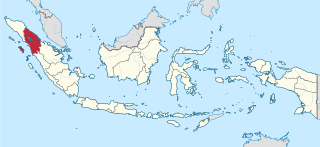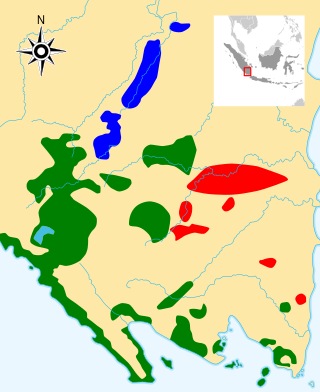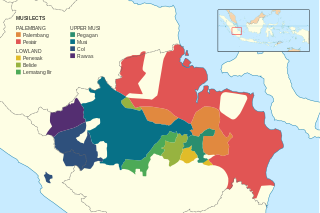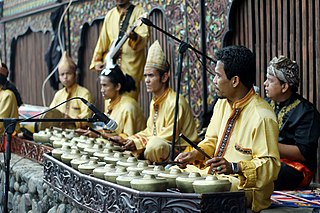Related Research Articles

Medan is the capital and largest city of the Indonesian province of North Sumatra. The nearby Strait of Malacca, Port of Belawan, and Kualanamu International Airport make Medan a regional hub and multicultural metropolis, acting as a financial centre for Sumatra and a gateway to the western part of Indonesia. About 60% of the economy in North Sumatra is backed by trading, agriculture, and processing industries, including exports from its 4 million acres of palm oil plantations. The National Development Planning Agency listed Medan as one of the four main central cities in Indonesia, alongside Jakarta, Surabaya, and Makassar. In terms of population, it is the most populous city in Indonesia outside of the island of Java. Its population as of 2023 is approximately equal to the country of Moldova.

Minangkabau is an Austronesian language spoken by the Minangkabau of West Sumatra, the western part of Riau, South Aceh Regency, the northern part of Bengkulu and Jambi, also in several cities throughout Indonesia by migrated Minangkabau. The language is also a lingua franca along the western coastal region of the province of North Sumatra, and is even used in parts of Aceh, where the language is called Aneuk Jamee.

North Sumatra, also called North Sumatra Province, is a province of Indonesia located in the northern part of the island of Sumatra, just south of Aceh. Its capital and largest city is Medan on the east coast of the island. It is bordered by Aceh on the northwest and Riau and West Sumatra on the southeast, by coastlines located on the Indian Ocean to the west, and by the Strait of Malacca to the east.
The Batin are a sub-group of Malay people that inhabits the interior parts of Jambi province

Lampung or Lampungic is an Austronesian language or dialect cluster with around 1.5 million native speakers, who primarily belong to the Lampung ethnic group of southern Sumatra, Indonesia. It is divided into two or three varieties: Lampung Api, Lampung Nyo, and Komering. The latter is sometimes included in Lampung Api, sometimes treated as an entirely separate language. Komering people see themselves as ethnically separate from, but related to, Lampung people.

The Sultanate of Deli was a 1,820 km2 Malay state in east Sumatra founded in 1632 when a commander of the Aceh Sultanate, Gocah Pahlawan, conquered the area during the reign of Iskandar Muda. A tributary kingdom from 1630 it was controlled by various sultanates until 1814, when it became independent and broke away from the Sultanate of Siak.

The Acehnese, also written as Atjehnese and Achinese, are an indigenous ethnic group native to Aceh, Indonesia on the northernmost tip of the island of Sumatra. The area has a history of political struggle against the Dutch colonial rule. The vast majority of Acehnese people are Muslims. The Acehnese people are also referred to by other names such as Lam Muri, Lambri, Akhir, Achin, Asji, A-tse and Atse. Their language, Acehnese, belongs to the Aceh–Chamic group of Malayo-Polynesian of the Austronesian language family.
The Simeulue language is spoken by the Simeulue people of Simeulue off the western coast of Sumatra, Indonesia.
Lawangan is an Austronesian language of the East Barito group. It is spoken by about 100,000 Lawangan people living in the central Kalimantan, Indonesia. Lawangan has a high degree of dialectal diversity.

Palembang, also known as Palembang Malay, is a Malayic variety of the Musi dialect chain primarily spoken in the city of Palembang and nearby lowlands, and also as a lingua franca throughout South Sumatra. Since parts of the region used to be under direct Javanese rule for quite a long time, Palembang is significantly influenced by Javanese, down to its core vocabularies.

Musi is a Malayic variety spoken primarily in parts of South Sumatra, Indonesia. While the name Musi in the broad sense can also refer to the wider Musi dialect network comprising both Upper Musi and Palembang–Lowland clusters, it is locally used as an endonym specific to the variety spoken in the upstream parts of Musi River.
Kendayan, or Salako (Selako), is a Malayic Dayak language of Borneo. The exact number of speakers remains unknown, but is estimated to be around 350,000.

The Lampung or Lampungese are an indigenous ethnic group native to Lampung and some parts of South Sumatra, Bengkulu, as well as in the southwest coast of Banten. They speak the Lampung language, a Lampungic language estimated to have 1.5 million speakers.

Aru was a major Sumatran kingdom from the 13th to the 16th century. It was located on the eastern coast of North Sumatra, Indonesia. In its heyday the kingdom was a formidable maritime power, and was able to control the northern part of the Malacca strait.
Tuanku Sri Paduka Gocah Pahlawan also known as Muhammad Dalik according to Hikayat Deli, was the founder of the Sultanate of Deli and the Sultanate of Serdang in North Sumatra, Indonesia. According to the tarombo from Deli and Serdang, Gocah Pahlawan was of keling (Indian) ethnicity, sent by Sultan Iskandar Muda in 1612 to rule in the former Aru Kingdom. He was appointed as a representative commander of the Aceh Sultanate for the area, to fight the Portuguese influence and establish alliances with the local population, who generally were Karo peoples.
Tuanku Panglima Perunggit, also titled Kejuruan Padang, was the second ruler (1641–1700) of the Sultanate of Deli. He continued the rule of his father Tuanku Panglima Gocah Pahlawan, who was the representative commander of the Aceh Sultanate to rule former area of the conquered Aru Kingdom. His mother's name was Putri Nang Bulan beru Surbakti, a sister of the Sunggal chieftain, Datuk Itam Surbakti, one of the rulers of the Karo people in Deli Tua.
Tuanku Panglima Paderap, also called Panglima Deli, was the third ruler of the Deli Sultanate, now part of North Sumatra, Indonesia. He succeeded his father Tuanku Panglima Perunggit, who died around 1700. Paderap had four sons, namely Tuanku Jalaluddin, Tuanku Panglima Pasutan, Tuanku Tawar, and Tuanku Umar.

Music of Minang is a traditional and contemporary ethnic variety of Indonesian music that grows and develops in the Minangkabau culture. Music is generally played by musical instruments such as talempong, saluang, Minang rabab, serunai, rebana, aguang (gong), gandang, gambus, and violin. However, for traditional events such as weddings, Islamic rebana or gambus are never used.

Djamaluddin Tambunan was an Indonesian bureaucrat and politician. He primarily served in the regional government of North Sumatera, reaching the rank of regional secretary in 1973 before being transferred to Jambi as the province's governor in 1974. After the end of his term as governor in 1979, he was transferred to the Department of Home Affairs to lead the department's research and development agency. He was elected as a member of parliament from Golkar in 1982 in 1987.

Malay has a long history as a lingua franca in the Malay Archipelago which currently includes Indonesia, Philippines, Malaysia, Brunei Darussalam, Singapore, East Timor, and the southern part of Thailand. This geographical variation, which then spread widely even to South Africa, finally led to the formation of a Malay language cluster which spread and had differences due to geographical conditions. The following is a list of Malay dialects and varieties summarized in one article.
References
- ↑ Husny, Tengku H.M. Lah (1978). "Lintasan Sejarah Peradaban dan Budaya Penduduk Melayu-Pesisir Deli Sumatra Timur 1612–1950". pustaka.kebudayaan.kemdikbud.go.id (in Indonesian). Jakarta, Indonesia: Departemen Pendidikan dan Kebudayaan. Retrieved 9 February 2024.
- ↑ Fungsi dan Kedudukan Sastra Lisan Melayu Serdang (in Indonesian). Jakarta, Indonesia: Departemen Pendidikan dan Kebudayaan. 1990.
{{cite book}}: CS1 maint: url-status (link) - ↑ Struktur Bahasa Melayu Serdang (in Indonesian). Jakarta, Indonesia: Departemen Pendidikan dan Kebudayaan. 1995.
{{cite book}}: CS1 maint: url-status (link)